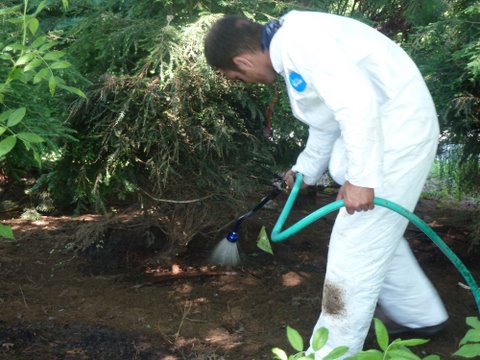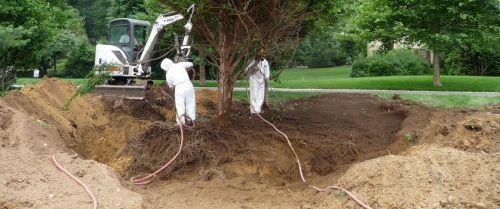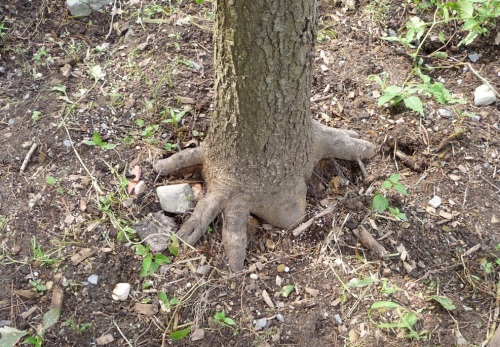The project showcased in the last post continued this week, with the bare-root transplanting of five London Plane trees (Platanus x acerifolia) and a mature crabapple. Again, Matthew R. Foti Landscape and Tree Service was the prime arborist on this site in a Boston suburb — but this week the Foti crew was joined by Mike Furgal, who was the first arborist to use the air tool for bare-rooting trees in this way.
Mike has been doing this work a bit over five years, and his expertise was the basis for the bare-root workshop sponsored by the Massachusetts Arborists Association and hosted by Matt last August. Neither arborist had moved this many trees of this size — the London Planes ranged from 11 inches dbh to 13″ dbh — and in teaming up they brought all their knowledge to bear to the challenges of this particular project. (The homeowner figured she had hired the A team, given the pair’s depth of knowledge and breadth of experience.)
I took a lot of photos during the first day, and returned today to shoot more. My colleague Bruce Jones and I also shot extensive videotape of the process, which is currently in editing, and will explain the sequence of bare-root transplanting using compressed air (watch this blog for word that it’s done and available).
To avoid computer-use burnout (mine), I’m posting one batch of photos today, and will add another post with more in a few days. I promise, this first batch of images will be plenty to digest for a while….
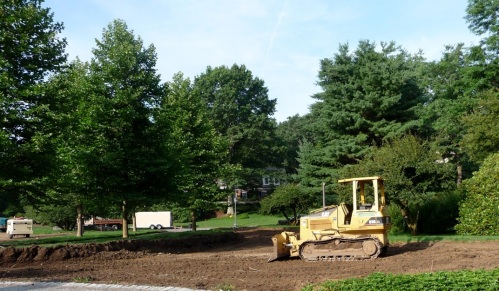
The site before the five London Planes get moved. The first tree to be excavated and moved is the one furthest from the camera, just to the right of the white trailer. These trees flanked a driveway; in this photo the driveway asphalt has been taken up and the gravel base has been partially removed. Trees are located 3-4 feet from the drive edge.

The mini excavator has dug a partial trench; the trench must be dug in sections, or it would be too difficult to reach in and haul out the blown soil. A climber is in the tree, tying in lines to be used later during transport.
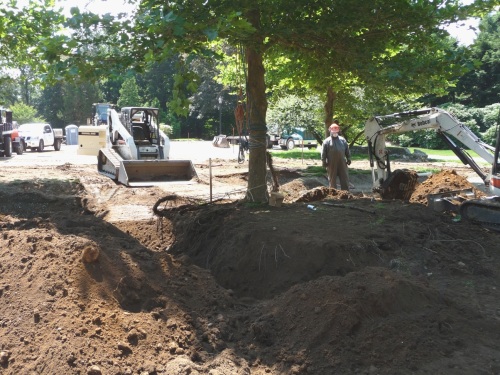
Bare-rooting has begun, and one pigtail of roots is already tied to the tree's trunk. The tree did not extend any roots into the gravel driveway base, so it only has 3-4 feet of root mass on that side. It did extend its roots out parallel to the driveway, and radially out into the lawn. A good depth of soil also let it sink its roots quite deep -- 2-3 feet -- into the ground. Mike Furgal is in the green jumpsuit and facemask.
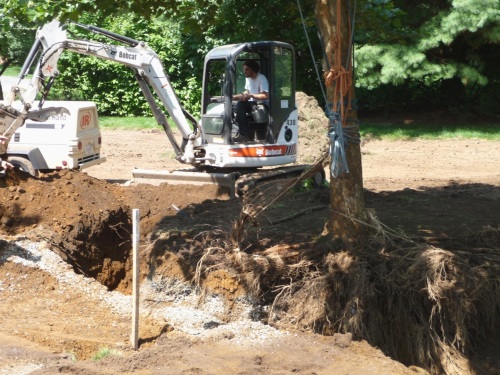
Pigtailed roots, and short roots along the driveway edge.

Good deep soil, good deep roots -- everywhere but at the gravel.

Lots of activity at the tree: two air-tool excavators, an mini excavator digging the trench, a Bobcat taking soil away, and Matt Foti assessing progress.
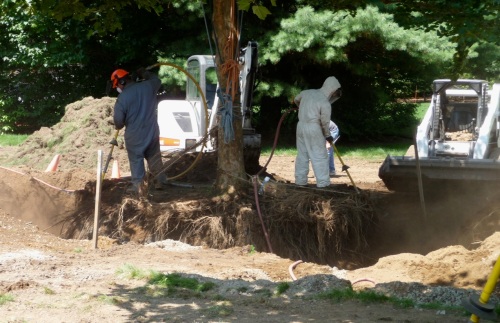
Blowing out soil, getting closer to the move.

Padding the trunk with layers of burlap for the move.

Giant forks have been run under the tree, and the loader is getting ready to lift it. Four taglines are visible in this shot; they won't prevent the tree from falling, but help indicate how it is balanced during the move.

Lifting and backing, slowly and very carefully.

A pause for the forks to be positioned more firmly.

Big machine, bigger tree. The root plate on this tree extended about 18 feet across at its maximum width. Transporting a large, upright live tree is a slow-speed operation.

Compare this root plate to that of a B&B tree, or a tree-spaded one (though this tree is too large for a tree spade), and it's clear what an advance this technology promises to be in benefiting the health of trees to be transplanted. The tree's energy reserves are largely stored in the roots; save the roots, reduce stress on the tree, and speed re-establishment after planting.

The tree, post-planting. The arborists assessed how deep the root mass was and how it was formed, and dug the planting hole to accommodate, roughly, its form. Once the tree is placed in the hole, the roots are spread out radially by hand, and loam shovelled in around, under, and over them. Watering starts during the digging process, once the tree has been levelled, so that a loam slurry anchors the root plate and tree to its new site. A well is formed to retain moisture and more water is added.

Two to four inches of mulch is added around the tree, and kept away from the trunk.

Minor pruning to fix a lamppost-branch conflict.

The transplanted tree seven hours later, in its new home.
Matthew R. Foti Landscape and Tree Service, Lexington, MA – lead arborist
Furgal Tree and Landscape, Northborough, MA – consulting arborist
Robert Hanss Inc. Landscape Construction — landscape contractor
Reed Hilderbrand — landscape architects (Chris Moyles, project manager)
Read Full Post »
